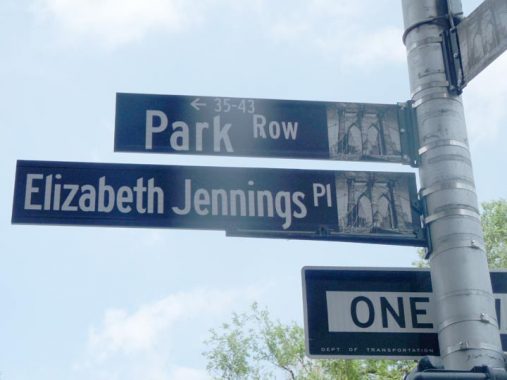
I really should have gotten a better photo of it from the other side, but fascinated by the sight of an honorific sign among the distinctive Downtown Alliance black and white street signs in lower Manhattan, I fired away at this sign at Park Row and Spruce Street, in front of the Pace University building later home to the New York Times. It turns out that the sign honors a woman who was the Rosa Parks of her era.
In 1853, mass transit was at its beginnings in Manhattan albeit in a crude fashion compared to today, with streel rails laid in the streets on which rode trolley cars pulled by horses. The Third Avenue Railroad Company began running such horsecar service on Park Row, then called Chatham Street, and the cars ran up the Bowery and then 3rd Avenue. In that era there was strict segregation and nonwhites were not permitted in the cars, despite their fare being just as good as anyone else’s. Only a few cars allowed nonwhites to ride; otherwise, they were forced to walk.
In July 1854 Elizabeth Jennings was an organist with the First Colored American Congregational Church and boarded a horsecar on the line at Chatham and Pearl Streets despite the edict, as she was running late. The conductor unsuccessfully attempted to get Jennings to leave the car and she resisted, subsequently removed by a policeman. (Reports differ on whether the conductor physically removed Jennings or the policeman did so.)
That was not the end of things, as Jennings wrote letters of protest to New York Daily Tribune and a paper run by Frederick Douglass. Her father had means, as he was one of the first African American patent holders for a dry cleaning solution, and hired a young Manhattan lawyer to sue the Third Avenue Railroad Company for discrimination. His name? Chester Alan Arthur, a future president of the United States. This was one of Arthur’s first cases at age 24, and his suit was successful — he cited an 1824 provision that the rail company was responsible for the safety of its passengers and spelled out clearly that that included “colored” passengers as well. The judge ruled in Jennings’ favor and she was awarded $225, four figures these days.
As part of NYC’s initiative to erect more statues of famed women around town, there will be a lifesize statue of Elizabeth Jennings installed at Grand Central Terminal in the near future.
Though many streets in the City Hall area have been eliminated by new construction and addition of traffic ramps connecting the Brooklyn Bridge and FDR Drive, the intersection of Chatham (now Park Row) and Pearl still exists, surrounded by the Daniel P. Moynihan courthouse, the Chatham Green housing project, One Police Plaza and the Metropolitan Correctional Center. Nonetheless, the honofic sign was placed a few blocks away at Park Row and Spruce.
More on Elizabeth Jennings in Curbed, 6 Sq. Ft. and a book by Jerry Mikorenda.
As always, “comment…as you see fit.” I earn a small payment when you click on any ad on the site.
7/3/21
